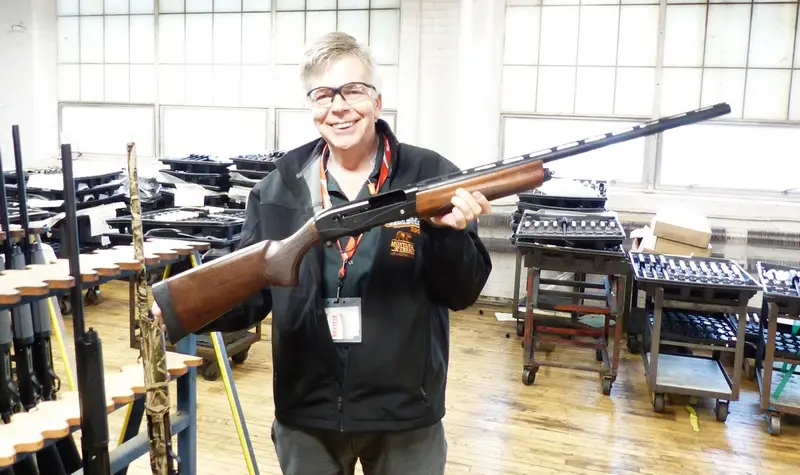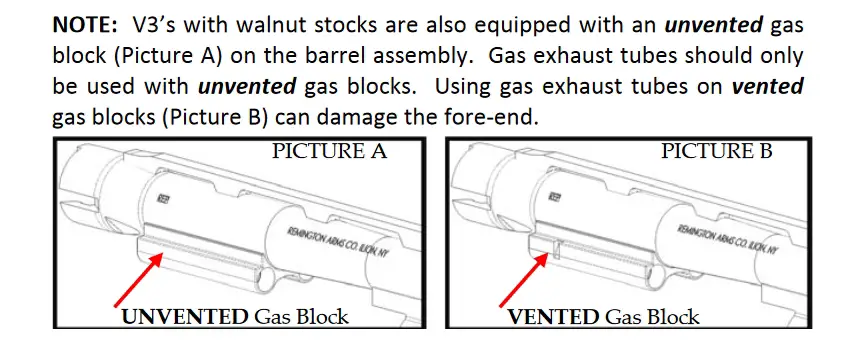On the Remington V3
The Beginnings
The dual gas piston idea was not at all original with Benelli, not even close. Mossberg had it in 1977, it was awarded in 1978, predating the Benelli M4 by over 20 years. It is patent# US4102242A. Since 1999, the Benelli M4 Super 90 has been the M1014 Joint Services Combat Shotgun with an 18-1/2 inch barrel, designated as the “M4 Entry” with a 14 inch barrel. The Cerakote non-collapsing stock civilian version currently sells for about $2000. In military trim, it weighs about 8-1/2 lbs., about 8 lbs. for the civilian version.
The original M4 models had two gas ports. However, the ARGO system isn't completely “Auto-Regulating Gas-Operated” as advertised. The 2 port barrels were quickly dumped for civilian sales in favor of the 4 port barrels, Benelli saying that the “M4 features a modified gas system designed to function with light tactical loads.” What constitutes a “light tactical load” is unclear. It was also called the M1014 (Low Recoil) for a time. While they were better at cycling low recoil and trainer type loads, they also had impressive failures when using heavy loads. Apparently, now, the 4 port barrel misadventure is over and only 2 port barrels are made. In one test, comparing Federal slugs the Benelli averaged 35 fps slower than the other common semi-auto shotguns with barrels of the same length.
In the twenty years since the M4 was designed, not much has happened except for the unfortunate misadventure with the 4 port barrel. Nothing was ever done to introduce an ARGO shotgun that could be rationally used for general hunting and clays purposes. Nine years ago when the pre-Vinci hoopla began, I mused that perhaps, finally, Beretta-Benelli was going to do something mainstream with the ARGO system, but that was not to be. As we all know now, it was the Vinci.
Remington improved on the basic A.R.G.O. Action of 1998, patenting their own action and their “VersaPort System,” and it has been released for some time now as the Remington Versa Max 3-1/2 inch chambered gas-operated autoloader. The Versa Max action was designed by Gian Mario Molinari of Italy, filed for patent on May 24, 2007, claiming priority over the Benelli patent filed a year earlier. On November 29, 2011, it was awarded to Remington. If you are interested, it is US 8,065,949 B1.
Although the 3 inch chambered ARGO system was touted as “Auto-Regulating,” it wasn't and isn't exactly. The Versa-Max, a 3-1/2 inch chambered gun, cleverly uses unfolded shell length to block off chamber ports. Eight ports open for 2-3/4 inch unfolded length shells four for 3 inch shells, and three for 3-1/2 inch shells. Automatically, there are three different gas port settings. The Versa-Max has been successful and there are now nine different models available, more than any other Remington autoloader.

At the Remington factory in Ilion, New York, when the first batches of the V3 Walnut were leaving the proof-testing area.
The Remington V3
Development of the V3 began in 2011 – 2012. A handful of prototypes were sent out for independent evaluation in 2014, when I first started shooting the V3. There were delays, though. In July of 2015, Remington wrote:
Randy,
We will begin production week of July 27th and continue building every week. We are a little late getting started due to extended endurance testing proving out some key dimensions. Unfortunately, doing extended endurance testing is time consuming and there is no way to accelerate it. We have elected to build inventory in August and September with shipments commencing in October. We realize we will miss early dove and teal seasons but felt it was more important to start shipping once we had a respectable quantity versus small shipments weekly. We appreciate your and everyone else's patience.
The
synthetic and synthetic camo models have been out for almost 3 years
by now in quantity and they have been successful. The V3 will go 2500
rounds without cleaning:
http://www.randywakeman.com/2500RemingtonV3.htm
. That's hardly best practice, it is filthy after that many shots,
but it will do it.
However, the walnut models were delayed until 2016. The vented gas block and the gas exhaust on the synthetic V3 was too much for walnut, forearm cracking was the result in testing, and that meant the developing of three different solutions and extended testing and re-testing after the design was finalized.
The V3 is the best all-around 12 gauge auto Remington has ever made. As far as I'm concerned, they need to do a couple of things to make it an all-time hit for everyone. It is going to take more models, for it has been just the synthetic for years, now just synthetic and the base walnut. Originally, I was told that the V3 would have shims. That was delayed, and then the ball was dropped. The last I heard, " the shim project is back on." Since that time, a lot has happened. Gun sales tanked, Remington has been in and now quite successfully out of Chapter 11, and today, gun sales are soaring . . . three straight months of all-time record sales. It isn't being driven by Joe Duckhunter or Betty Doveblaster. It is pistols and AR-15's, and that isn't the V3.
The United States Gun Market Today
According to the ATF: “... through calendar year 2015. Rifles made up the bulk of the firearms manufactured at 3.6 million in 2015. Pistols were a close second at 3.5 million.” When you look at imports, it become readily apparent that the biggest market is handguns. In 2015, 2,470,101 handguns were imported into the United States, growing to 3,671,837 handguns imported into the U.S. in 2016.
In 2016, Remington manufactured 385,871 shotguns in the U.S. In 2016, Mossberg made 367,542 shotguns in the U.S. In 2016, 848,617 shotguns were made in the United States. 88.8% of all shotguns made in the United States are from Mossberg or Remington. In 2016, Beretta USA made 28,067 shotguns in the U.S. In 2016, Remington 584,883 rifles in the U.S. In 2016, 5,576,366 handguns were made in the U.S. In 2016, 4,239,335 rifles were made in the U.S. In 2016, 848,617 shotguns were made in the United States. In 2016, 833,123 miscellaneous firearms were made in the United States. Of the 11,497,441 firearms made in the United States in 2016, 7.4% were shotguns.
Handguns sold in the United States are in the range of 6 – 7 million per year, easily dwarfing the numbers of everything else. This should explain, in part, why Remington continues to expand their 1911 line (now at twenty-four models), the RP striker-fired line, and their handgun offerings in general. Shotgun aficionados have a tendency to care only about shotguns, and then only about the types of shotguns they happen to own. It is only natural. Even though Remington and Mossberg dominate the U.S. made shotgun market and have for several decades, shotguns are hardly Remington's only product. Remington has recently released their line of detachable box magazine 870s, but also their Model 700 PCR precision chassis rifle, their affordable RP45 15-round .45 ACP handgun, and several complete lines of ammunition from Remington and Barnes. Remington has a lot of product segments in the mix, many new products, and it isn't all shotguns.
Finally
The
top-selling lever-action on Gunbroker for May, 2018, is the Marlin
1895. As far as the V3: the Remington V3 Field Sport is a hot-seller
as well according to Gunbroker: it is #3, behind only the
Turkish-made (Armsan) TriStar Raptor as far as semi-auto gas-operated
shotguns. It is even more impressive when you consider that the V3
is available only in two basic models, both 12 gauge, while the
Raptor is offered in 12 and 20 gauge, including youth and tactical
models. Notably, no Browning, Beretta, or Mossberg semi-auto hit the
top five.

The gas block and venting system on the walnut, the tube
array, is superior to the synthetic. It can be used with
forearms of essentially any material, it keeps the magazine tube a
bit cleaner, it is easier to service, and it can be used to fine-tune
the action by varying the inside diameter of the tubes. Although I
have not personally felt any gas “blow-back” on the countless V3
models I've used, some have claimed they do and the walnut's tube
system eliminates that potential as well. It only makes sense to standardize
for the long haul. Right now, Remington manufactures two different types of barrels: they need only make one.
That indicates just a minor forearm redesign on the synthetic
models to accommodate the exhaust tube ends: in other words, venting of the synthetic forearm that matches the venting on the walnut forearm, which is currently not the case.
While
they are at it, they might as well get the bloody shims done. I don't
need them. personally, but that isn't the point. Some people either
do need them or just want them, and no one would object to having them
available. Remington can also take what they have learned from the
last three years of 12 gauge production and apply it to a V3 20 gauge
out of the gate.
The V3 begs for tactical / turkey hunting
models and also higher grade upland and clays models to fill out the
line. I personally would appreciate a "Waterfowl Pro" version, just like they did with the Versa-Max. Others have different
ideas. The walnut version has one massive hunk of walnut for the
butt-stock. That could be channeled out and would lighten the V3
walnut model a bit which at least I would appreciate. If a 20 gauge
V3 is released, that of course would take care of the weight as a
matter of course and please most upland hunters at the same time. However, as of this writing, there is no target date set for a 20 gauge V3.
The Remington V3 has been a very successful and well-received product. Although it is already past mid-June, Remington is hard at work finalizing several new models for a potential fall, 2018 release. Of the 4-6 additional models being worked on, one will have shims, so shims will be available thereafter for those who want them. No specific model information is available at this time, and plans can of course change based on the results of the requisite endurance testing and several other variable factors.
Copyright June, 2018 by Randy Wakeman. All Rights Reserved.












